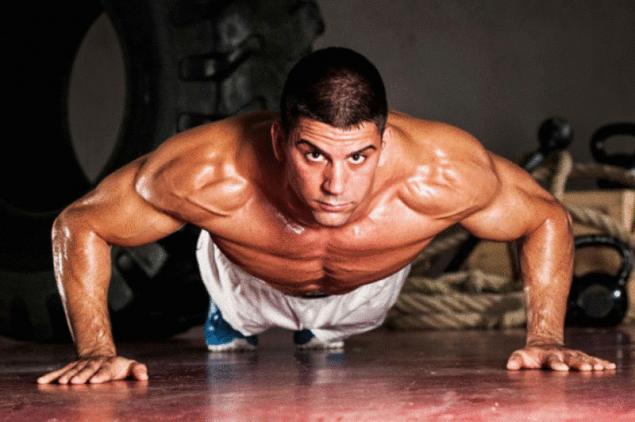506
How to perform push-UPS?

Push-UPS – this is one of the best exercises ever invented by mankind. They require no equipment, develop strength of several muscle groups, have hundreds of versions of perform for fans. Progress in push UPS is very easy to follow, and today there's a multitude of training systems based on the push-UPS. So let's say thanks to that ancient caveman who was the first to wring out from the floor of his cave and move on to the main part of the article: how to perform proper pushups, how to do push-UPS from scratch, and what are the different types of push UPS?
What muscles work when push-UPS? Why are pushups so famous and popular? As was said above, they are comfortable, if I may say so, undemanding, and involves several muscles. Such exercises are called basic. The main load during a push-up falls on the chest muscles and the shoulder muscles (Delta and triceps). Part of the load goes to biceps, back and press. From this we can say that push – UPS are an excellent exercise for training the upper body. In conjunction with squats (legs) and pull-UPS (back) push-UPS can be the basis of any home workouts that don't require anything except a little space and a bar for pull-UPS.
Preparing to perform push-UPS Like any exercise, when performing push-UPS is very important the correct technique. Proper pushups – this is a guarantee that you properly bleed all the muscles and wow will not pull and will not hurt. Also proper technique is important in order to correctly evaluate your progress. And if you did yesterday 30 the "correct" push-UPS, and today – all 60, but it fell only halfway and stuck out in the air his soft spot, it does not mean that you become stronger. Most likely, you just relax. So let's agree on this and we assume so in the future: all the push-UPS you perform the correct technique, and if not – then the load is too large, and it makes sense to do push-UPS on a higher support and less number of times.
So, here are a few points that will help you tune to the correct execution of push-UPS:
- When you fall to the floor, your hands should be slightly wider than your shoulders. Regardless of your strength and fitness during exercise you must be comfortable. Before beginning the workout in my free time experiment in the emphasis lying – what location is most convenient for you? For example, I comfortably put your hands where the middle finger pointed straight ahead. It should be noted that setting of the hands at shoulder width characteristic of the classic push-UPS, which load in more chest and less triceps. If you put your hands already, then the load will be redistributed and become more complex "tritasavit pushups." If greatly put – out push-UPS with maximum emphasis on the chest muscles, and the exercise of the basic moves in almost isolated (one or two muscles). These two options get much more complicated in execution, and I recommend to try them only when you master regular pushups.
- Your feet should stand as well as comfortably. Someone comfortable when the feet, like hands, are shoulder width apart, someone – when they are brought together and touch. The position of the feet in this exercise is not particularly essential, therefore make you comfortable. Let me just say that the wider your legs are, the harder you exercise, but you will be in greater balance.
- Your body should be stretched in one straight line from head to feet. This means that you should not omit or greatly raise the head and bulging of the loin part :) Remember, the more directly you squeeze, the better it will be perceived burden, and the safer it will be exercise.
- If for some reason you difficult to accept the correct position, then try the following. Get in push-up position as you wish, and then squeeze your buttocks and press, plunging the stomach. This will straighten the spine, pushing you to the right position.
- During push-UPS the head should look forward, not down. Steve in the pictures looks down only because he began to do push-UPS. As soon as the start – up, and will look exactly in front of him, and his body will be pulled out in a straight line (as the fourth picture).
- In the starting position your arms should be straight and hold the weight of the entire body.You are now ready to push-UPS.
- Keeping a straight body position, gradually lower yourself chest to the floor, bending your elbows to 90-degree angle (or less). If you are more or less prepared physically, will be convenient to stoop to the moment when the chest slightly touches the floor. Try to figure out the optimal moment, and then he and a guide.
- Keep the elbows closer to the body, and if they start to diverge in hand, this means that you are tired.
- Once you get down to the desired level, hold for a moment, and then the explosive movement of the arms return to starting position.
- Congratulations, you just completed one pushup from the floor. Now, make a few more push-UPS until you feel that you find it difficult to hold the correct body position. If your hands begin to tremble treacherously, and you feel that for the next pushup you need to rest on the floor or to help with a jerk of the legs or back, so this is your high for today. It is not necessary to engage in "cheating", ten right and five "con" push-UPS is much less than eleven correct. Only performing push-UPS with correct technique will allow you to assess your progress in the regular classroom.
I want to mention two issues that often concern to beginners.
Question: why my lower back hurts, although the main burden falls on the hands?
Answer: most likely this is caused by weak muscles of the waist and the press fix bad spine. Over time, the lower back will get used to it, but I suggest you to pay during training more attention to these lagging muscles.
Question: why are my head and neck?
Answer: most likely, this is caused by some problems in the cervical spine (e.g., muscle spasm) or weak blood vessels. Consult your doctor and he will help to adjust your program for your case. Make sure you keep your head during the exercise.
How to learn to do push-UPS from scratch , You say, "But I can't do even one push-UPS, how can I learn?" OK, anything can happen, and here's a tip that will allow you to learn how to do push-UPS. As the classic push-up is a comprehensive and somewhat complex movement, it is necessary to simplify, and to gradually return to the original, correct version.
Start with pushups from the wall. In the same way as in a standard pushup, place hands shoulder width apart (even more) on the wall and straighten your body. Do one or two steps back, until you feel that the main weight of the body falls on the hands. Now gently lower yourself towards the wall by bending your elbows until will barely touch the wall with your nose. Hold for a split second and jerk vibrates.
Do 4 sets of push UPS from the wall with two minutes rest between sets, mark your progress, and as soon as you reach 20 reps in each set, proceed to the next stage. That these 80 push-UPS must be technically correct, I don't even recall.
The next step is push-UPS from the support.
Support Desk, chest of drawers, a bench or something in the same spirit, that is not a wall but not the floor. In my opinion, the best support at this stage will be written or a standard kitchen table height 75 cm Technique push-UPS from the support is absolutely the same as before, except that because of the changing angle will be harder to lower your body to the fulcrum than to the wall.
Once you reach the promised number in 4x20 reps, go down even lower. You can approach a low stool, box, beam or stair. In General, the ladder allows a chance to evaluate progress on the push UPS and increase your strength when you start 4x20 pushups from the fifth step, and end with the 4x20. The last level is already half.
How to speed up your progress in the push-UPS so now you know what pushups how to do pushups correctly and how to learn to do push-UPS from scratch. Now I want to tell you that you can do in order to achieve the best results, push-UPS.
- Keep an active, healthy lifestyle and eat right. It becomes less your weight, the more and better you can do push-UPS.
- Not cheats on the last repetition. It's called "cheating", many training techniques it is appropriate, but not in the case of push-UPS. If you are unable technically to perform the last repetition, then better leave it and try to "take" next time. Trying to pull of that muscle growth of these muscles will not, remember that our goal is to get strength and not to record the beautiful figure in his diary.
- Don't exercise two days in a row. Muscles require up to 48 hours to recover.
- After half an hour after a workout take a serving of protein, this will give your muscles the energy needed for growth.
- To perform pushups will not interfere with the strong press and muscles "bark", so add to your workout, static exercises to support the weight of the body, called "slats".
Even a successful and diverse program "100 pushups" may sooner or later get bored due to the fact that people mostly do not like monotony and stagnation, in fact quite boring to perform the same movement for months.
They may be interested in the following options:
- Pushups on one leg. In principle, nothing complicated, just have to pay more attention to balance.
- Pushups on one hand. The second is given back, and the legs are placed as widely as possible.
- Pushups with cotton (or plyometric pushups). Instead of returning to the original position you make a strong move to literally jump into the air while managing to make the clap of your hands, and then land in the starting position and without resting again, drop.
- Tritasavit push-UPS. The hands are not shoulder-width apart, and already, approximately in front of chest. Fingers facing forward. This exercise is aiming to develop the shoulder muscles, particularly the triceps.
- Pushups on my knuckles/fingers. Popular among people involved in martial arts because additionally develop the power brush.
- Deep pushups. If normal push UPS you go down almost to the floor, you will have to fall even further. How to do it? For example, do push-UPS, standing in the emphasis on the two standing parallel benches or push-UPS placing hands on two chairs.
- And many others. There are a huge number of different variants of pushups, and I think it is worth to devote a separate article.
Author: Mikhail Soloviev
P. S. And remember, just changing your mind - together we change the world! ©
Source: folkextreme.ru/2012/09/pushups/
Why the love for online shopping continues to grow stronger?
Smile more! The functional value of a smile






















